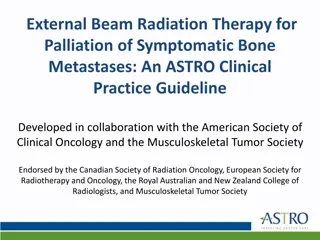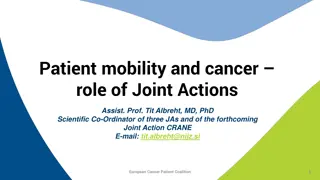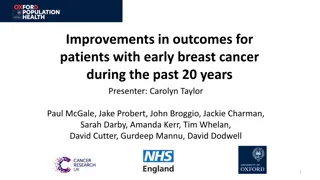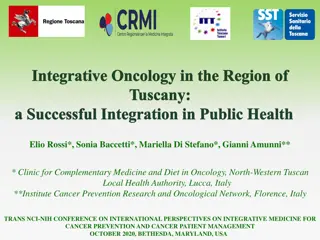Metastases in Cancer
Metastases in cancer refer to cancer cells spreading from the original tumor to other parts of the body through the bloodstream, lymphatic system, or direct extension. This content discusses cases of metastatic cancer, including imaging findings, staging, and biopsies, highlighting the challenges in diagnosing and treating advanced cancer.
Download Presentation

Please find below an Image/Link to download the presentation.
The content on the website is provided AS IS for your information and personal use only. It may not be sold, licensed, or shared on other websites without obtaining consent from the author.If you encounter any issues during the download, it is possible that the publisher has removed the file from their server.
You are allowed to download the files provided on this website for personal or commercial use, subject to the condition that they are used lawfully. All files are the property of their respective owners.
The content on the website is provided AS IS for your information and personal use only. It may not be sold, licensed, or shared on other websites without obtaining consent from the author.
E N D
Presentation Transcript
CUP Carcinoma of unknown primary
Case 1 60 year old female px to hospital for an angiogram of the lower limb of intermittent claudication likely PVD. PMHx: Hypertension Hypercholesterolemia Likely COPD- no formal diagnosis Social Hx: Retired personal care attendant. Longstanding smoker, still smoking approximately 40pack years . ECOG 1.
Progress Angiogram complicated by a retroperitoneal bleed CT abdo: multiple liver lesions and lung nodules Staging: Wide spread bone liver metastasis Multiple pulmonary nodules through both lungs with the largest in the right lung measuring 20 mm. CT-guided core biopsy of liver lesion highly suspicious of malignancy non diagnostic. Referred to oncology: History obtained of headache for many months very persistent and often worse on lying flat and in the mornings. CT brain. >23 metastases Mx?
Case 2 47 year old female px with severe back pain on b/g of months of being generally unwell n/v/ anorexia with 6 KG of weight loss over 2/12 Nil other sx PMHX: HT Obesity Social: Married with 3 children Occasional ETOH Non-smoker Father died of Lung Cancer 70 s(Smoker)
Case 2 Staging CT C/A/P: intra-abdominal lymphadenopathy and metastasis to bone, liver Nil primary seen Pet Scan: Wide spread metastatic disease including lung liver and bone , nil primary seen Biopsy liver: Adenocarcinoma Ck 7-, CK20+ Mx?
Metastases What are they? Cancer cells that leave the original tumor site and migrate to other parts of the body Migrate to other parts of the body via bloodstream lymphatic system direct extension
The development of metastases1 1- Hanahan et al 2011
? Why do cancers go to specific sites ? arrest within capillary beds due to the layout of the vasculature and size restrictions imposed by blood vessel diameters ? actively home to specific organs via genetically pre-determined interactions b/w cancer cells and the luminal walls of the microvasculature Unknown
Cancer of unknown primary site (CUP) Histologically proven metastatic tumours whose primary site cannot be identified during pretreatment evlaution4 4- 5 % of all invasive cancers5 8th most common cancer in men 9th most common in women Sx: Usually from the metastatic disease Early dissemination, unpredictable, aggressive LN only mets median survival 6-9 months Extranodal median survival 2 months 4- NCCN guidelines 5- Hainworth et al 2013
CUP Adeno CA 70% CUPs. 2/3 primary lung, pancreas, hepatobiliary tree and kidney Px mets to liver, lungs, lymph nodes, and/or bones. SCC 5 % CUPs Classic sites of SCC Px lymphadenopathy Changing face of head and neck SCC Poorly Differentiated 20- 25 % CUP Cannot distinguish between a carcinoma, sarcoma, melanoma or haematologic malignancy based upon light microscopy Very important to keep testing
CUP Neuroendrocrine 1 % CUP Low-grade neuroendocrine carcinoma liver metastases. High-grade neuroendocrine carcinoma metastases in multiple sites 5 major subtypes Well- moderately differenced adeno Poorly differentiated adeno/ Undifferentiated adeno / undifferentiated carcinoma SCC Poorly differentiated malignant neoplasms Neuroendoricne Multiple chromosomal abnormalities and overexpression genes EGFR,CKIT, PDGR,RAS,BCL2,Her2 Targets for the future
Favorable Prognosis Papillary adenocarcinoma of the peritoneal cavity in women Poorly differentiated carcinoma with a midline distribution Poorly differentiated neuroendocrine carcinomas Adenocarcinoma involving only the axillary LN women SCC involving cervical lymph nodes SCC isolated inguinal adenopathy Blastic bone metastases + elevated PSA men Single, small, potentially resectable tumour
Poor prognosis Male Poor performance status Adenocarcinoma with multiple sites of mets (liver, lung, bone) Non-papillary malignant ascites (adenocarcinoma) Peritoneal metastases Multiple cerebral mets (adenocarcinoma or SCC) 80%
Workup: History Symptoms Pain Change in bowel habit Melena Cough PMHX Hepatitis C Screening Pap smears, mammogram Social Hx Smoking Squamous Cell Lung, Head and neck, Esophagus Occupation Asbestosis Family Hx Examination Baseline investigations Pathology Imaging Sites of secondary disease Pattern of distribution
Classic sites of disease Tumour Typical sites of mets Bladder Bone, liver, lung Breast Bone, brain, liver, lung Colorectal Liver, lung, Peritoneum Kidney Adrenal , bone, brain, liver, lung Lung Adrenal gland, bone, brain, liver, other lung Melanoma Bone, brain, liver, lung, skin/muscle Ovary Liver, lung, peritoneum Pancreas Liver, lung, peritoneum Prostate Adrenal gland, bone, liver, lung Stomach Liver, lung, peritoneum Thyroid Bone, liver, lung Uterus Bone, liver, lung, peritoneum, vagina American Cancer Society Cancer of Unknown Primary [Revised 7/2/14, cited 16/8/14] Available at http://www.cancer.org/cancer/cancerofunknownprimary/detailedguide/cancer- unknown-primary-cancer-of-unknown-primary
CUP Workup ctd Tumour markers Generally a guide only Not alone in diagnosis Further Imagining PET Other Colonoscopy Gastroscopy Biopsy Adenocarcinoma Squamous cell carcinoma Neuroendocrine carcinoma, well differentiated or poorly differentiated Mesothelioma Melanoma Germ cell tumor Poorly differentiated tumors carcinomas lymphoma sarcoma Other Hormone positive
Immunohistochemistry Process of detecting specific proteins in biological tissues Detects antigens by binding antibodies In CUP Useful to guide cell-type determination and pathological diagnosis Good for the characterisation of poorly differentiated or undifferentiated tumours Not uniformly specific or sensitive Has not been proven to improve outcomes
Immunohistochemistry Common Antigens TTF-1 thyroid and lung WT1 mesothelioma S100 melanoma, clear cell sarcoma, glioma Cytokeratins7/20 2 most common immunostains used in CUP CK CK 20 GIT CK 7 lung, ovary, endometrium, thyroid breast
Molecular profiling Using gene signatures/ expression profiles to determine likely site of origin More accurate than IHC in poorly differentiated or undifferentiated carcinoma Predicts up to 75% of cases in some trials Multiple GEP assays Outcome data not yet available GEP Shouldn't be used routinely yet, but can be considered Combination IHC and GEP increase diagnostic accuracy
Treatment Optimum treatment difficult without the identification of the site of origin
Treatment of CUP 1) Treat by Primary site If a primary site can be identified or is strongly suggested 2) Favorable Prognosis Tailored treatment approach Locoregional treatment Specific chemotherapy Likely to provide clinical benefit and prolong survival 3) Poor Prognosis Empiric setting chemo is recommended but benefit is questionable Combinations platinum + one another cytotoxic agents taxanes, gemcitiabine, irontecan
Meta-analysis Search databases Ovid MEDLINE, EMBASE, Cochrane 1980- 2011
Inclusion Criteria Studies on chemotherapy for the unfavorable subset of CUP First line treatment Excluded; Favorable subsets
Methods: Multiple meta-regression model for testing the significance of the differences b/w platinum and no-platinum; taxane and no taxane; P1T1, P1T0, P0T1, and P0T0 Pre- defined subgroup analysis male histology of moderate- to well differentiated adenocarcinoma ECOG<2 liver metastasis, multiple metastatic sites year of the study
Results 1389 potentially relevant studies, 1281 were excluded 32 of them met all the criteria for inclusion 7 RCTs 1 nonrandomised trial where two treatment arms were evaluated. 1 consecutive case series study 23 studies were single arm clinical trials 66% contained platinums 34% included taxanes 14 studies reported prospective calculation of the study size 1 RCT clear description of the method of allocation concealment No RCT was blinded
Results Across all chemotherapy Median survival 9.0 months (95% CI: 8.1 9.8), 1-year survival rate 35.6% (95% CI: 32.0 39.3), 2- year survival rate 18.6% (95% CI: 15.4 21.7) Platinum vs non-platinum Median survival time of 9.4 vs 7.2 months; 1-year survival rate of 36.9% vs 29.6%; 2-year survival rate of 19.7% vs 11.9% Taxane vs non-taxane Median survival 9.6 months vs 8.3 months 1-year survival rate 41.3% vs 30.8% 2- year survival rate 21.2% vs 16.4%
Results Outcome Regime Coefficient P-value Median survival months Platinum .76 (-1.14 to 2.67) .43 Taxane 1.52(.12-2.92) .03 No Platinum No Taxane Reference Platinum No Taxane .78(-1.16-2.72) .43 No Platinum Taxane 2.58(-1.09-6.26) .17 Platinum and Taxane 2.02(-.05 to 4.09) .06
Results the median survival related to histology ECOG The 1- and 2-year survival probabilities were related gender ECOG performance status Presence of liver metastasis
Summary of analysis Lots of potential confounders Consider taxane/platinum if patient well enough
NCCN Treat only: Patients with disseminated disease who are symptomatic have a PS of 1-2 Or asymptomatic patients with a PS of 0 with aggressive disease
General chemo principles Adeno Consider cisplatin, taxane, gem combos Poorly differentiate adneo or carcinoma or undifferentiated CUP seem to be highly response to cisplatin SCC 5fu, platinums
Summary CUP- Heterogeneous group Consider IHC or GEP to assist diagnosis Treatment: if PS allows 1)Treat as Primary or 2)By Prognosis Good prognosis Poor prognosis Consider taxane Future: Better testing more directed treatment
Case 1 A repeat biopsy (liver): showed metastatic carcinoma, strong staining with CK7 and TTF-1 Ax: Likely Lung Primary Mx: Urgent Radiotherapy to the brain Consideration to be given to Palliative chemo + bisphosphonate Carbo/gem Progress: Completed radiotherapy to the brain Await daughter return from OS Came for routine oncology appointment New right hip pain X-ray: pathological fracture Surgery Died 1.5 weeks later
Case 2 Mx: Colonoscopy Mass detected at the large bowel splenic flexure Biopsy: Adeno Ck 7-, CK20+ RAS mutant Tumour markers: Elevated CEA Chemo? Yes- as per met bowel CA FOLFOX/Avastin
References Hanahan, D. Weinbery, R. Hallmarks of Cancer: The Next Generation, Cell March 2011;144;5;646 674 Valastyan, S. Weinbery, R Tumor Metastasis: Molecular Insights and Evolving Paradigms Cell Volume 147, Issue 2, 14 October 2011, Pages 275 292 Hainworth, J. Greco, A. Overview of the classification and management of cancers of unknown primary site UpToDate [created January 2013, cited 16/8/14] Accessed from :www.uptodate.com J Lee1, S Hahn*,1,2,3, D-W Kim1,4, J Kim3, S N Kang3, S Y Rha6, K B Lee7, J-H Kang8 and B-J Park Evaluation of survival benefits by platinums and taxanes for an unfavourable subset of carcinoma of unknown primary: a systematic review and meta-analysis British Journal of Cancer (2013) 108, 39 48 | doi: 10.1038/bjc.2012.516


























